
Title: Navigating the Vast Landscape of the Search Engine Marketing Ecosystem
The realm of Search Engine Marketing (SEM) stands as a pivotal component in the digital marketing universe, a landscape continuously evolving and expanding its horizons. The essence of SEM lies in its dual components: organic search results and paid network ads, both of which play crucial roles in the visibility and accessibility of online content. This introduction delves into the intricate balance between these two elements and explores the transformative journey of SEM over the years.
At its core, SEM is a strategy that aims to increase a website’s visibility on search engine results pages (SERPs). This is achieved through two primary pathways: Search Engine Optimization (SEO) and Pay-Per-Click (PPC) advertising. SEO involves optimizing website content to naturally appear in search results for specific keywords, thereby generating organic traffic. In contrast, PPC encompasses the use of paid advertisements that appear at the top of SERPs, offering immediate visibility in exchange for a fee every time the ad is clicked.
The evolution of SEM has been marked by significant milestones, reflecting the ever-changing landscape of internet usage and search engine algorithms. In the early days of the internet, search engines were relatively basic, and SEO techniques were straightforward, often relying on keyword stuffing and meta-tags. However, as search engines like Google developed more sophisticated algorithms, the art of SEO evolved into a more complex and nuanced practice, focusing on high-quality content, user experience, and relevance.
Simultaneously, the world of paid advertising has undergone its own revolution. From simple text ads to today’s dynamic and interactive formats, paid ads have become more targeted and efficient. Platforms like Google Ads and Bing Ads have provided advertisers with powerful tools to reach their desired audience based on demographics, interests, and online behavior.
The interplay between organic and paid strategies is a delicate balance. While organic SEO is a long-term investment that builds credibility and authority, PPC offers a quick way to gain visibility and can be particularly useful for new websites or during promotional campaigns. The effectiveness of both strategies depends largely on the ever-evolving algorithms of search engines, which are continually updated to provide users with the most relevant and high-quality search results.
Moreover, SEM’s landscape has been reshaped by the rise of mobile internet usage and voice search. These trends have compelled marketers to adapt their strategies for local SEO, mobile-friendly website designs, and keyword optimization for natural language queries. The increasing importance of local search, driven by the ubiquity of smartphones, has opened new avenues for local businesses to enhance their online presence and attract nearby customers.
Another significant aspect of SEM’s evolution is the heightened emphasis on user experience and intent. Modern search engines prioritize websites that offer valuable, engaging, and easy-to-navigate content. This user-centric approach has led to more sophisticated content marketing strategies that not only aim to rank well in search engines but also provide real value to the audience.
In conclusion, the SEM ecosystem is a dynamic and complex field that requires a deep understanding of both organic and paid search strategies. Its evolution over the years reflects broader technological and behavioral shifts in internet usage. As businesses navigate this vast landscape, they must continually adapt and refine their approaches to remain competitive and relevant in the ever-changing digital marketing world.
Section 1: The Dynamics of Organic Search and Paid Ads
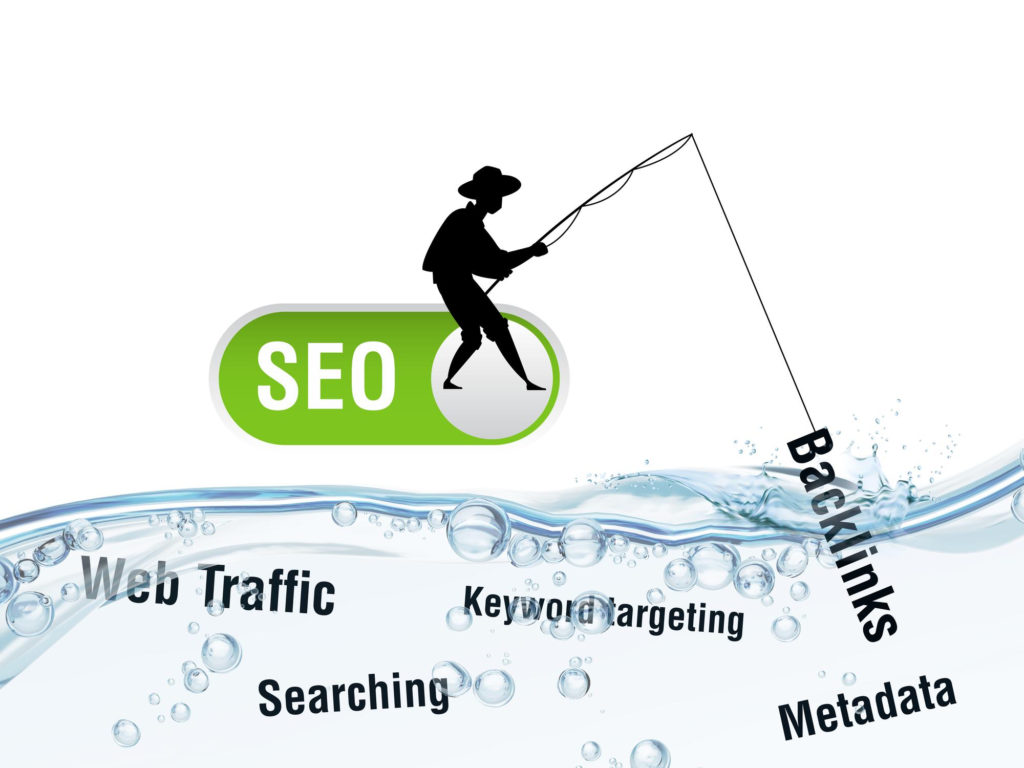
In the vast domain of Search Engine Marketing (SEM), understanding the dynamics of organic search and paid advertisements is crucial for any digital marketing strategy. These two components, though fundamentally different, work in complementarity, offering a blend of long-term brand building and immediate visibility. This section explores these aspects, shedding light on how they operate distinctly yet synergistically within the SEM ecosystem.
The Essence of Organic Search Organic search refers to the natural listings on search engine results pages (SERPs) that appear due to their relevance to the search terms, as opposed to paid advertisements. The primary driver of organic search visibility is Search Engine Optimization (SEO), a methodology focused on optimizing website content, structure, and on-page elements to make them more attractive to search engines. The goal of SEO is to rank as highly as possible on SERPs for specific keywords or phrases relevant to the business or content being promoted.
The beauty of organic search lies in its ability to contribute to long-term brand credibility and visibility. Unlike paid ads, which are clearly marked as sponsored, organic search results are perceived by users as more authentic and trustworthy. This perception stems from the understanding that a high-ranking organic result has earned its place through relevance and quality, rather than financial investment in advertising.
SEO’s focus on content quality, user experience, and keyword relevance means that a well-optimized site naturally attracts visitors who are actively searching for information, products, or services related to what the site offers. This alignment between the user’s intent and the content’s relevance not only drives traffic but also builds the brand’s authority and credibility over time. As users repeatedly encounter a brand in organic search results, trust and recognition grow, establishing a solid foundation for long-term business success.
The Power of Paid Network Ads On the other side of the SEM spectrum are paid network ads, which offer a different but equally vital set of advantages. These advertisements are typically displayed at the top or bottom of SERPs and are clearly labeled as ads. The most common model for these ads is Pay-Per-Click (PPC), where advertisers pay a fee each time their ad is clicked.
The immediate impact of paid ads is one of their most significant advantages. Unlike the gradual process of building organic search visibility, paid ads offer instant visibility and can quickly drive traffic to a website. This immediacy is particularly beneficial for new websites, time-sensitive promotions, or businesses looking to gain quick exposure in a competitive market.
Paid ads also provide unparalleled versatility in targeting specific audiences. Advertisers can use a plethora of targeting options, including demographics, interests, location, and even the time of day, to ensure that their ads are seen by the most relevant audience. This level of targeting precision allows for highly effective and efficient advertising campaigns, as ads are only shown to users who are most likely to be interested in the product or service being offered.
Another advantage of paid ads is their ability to protect businesses against the fluctuations and unpredictability of search engine algorithms. Organic search rankings can be significantly affected by algorithm updates, which can happen frequently and without warning. By investing in paid ads, businesses can maintain visibility even when their organic rankings fluctuate.
Complementarity of Organic and Paid Strategies The most effective SEM strategies often involve a combination of both organic and paid efforts. This complementary approach maximizes the strengths of each method. While organic search builds a foundation of credibility and long-term visibility, paid ads provide immediate exposure and targeted reach.
For instance, a business might use SEO to rank for broad industry-related terms, establishing authority and brand awareness, while using targeted PPC campaigns for specific products or promotions. This dual approach not only increases the overall visibility of the brand but also ensures that different aspects of the marketing funnel are being addressed, from awareness to conversion.
The interplay between organic search and paid advertisements is a delicate balance that forms the backbone of SEM. Understanding the unique benefits and limitations of each, and how they can complement each other, is essential for any business or marketer looking to navigate the complex landscape of search engine marketing successfully. By leveraging the long-term brand-building power of organic search in tandem with the immediate impact and precision targeting of paid ads, businesses can create a robust, multifaceted strategy that drives both visibility and growth.
Section 2: Revenue Streams and Market Reach

In the intricate web of search engine marketing, the revenue streams and market reach of various platforms paint a vivid picture of the industry’s dynamics. This analysis takes a closer look at the estimated revenues of leading search engines and ad networks, juxtaposing the global reach and user base of giants like Google against emerging players like Snipesearch. Additionally, we’ll delve into the privacy implications associated with using networks like Google Ads and Bing Ads versus more privacy-conscious options like Snipesearch Ad Clicks and a-ads.
Estimated Revenues and Market Penetration
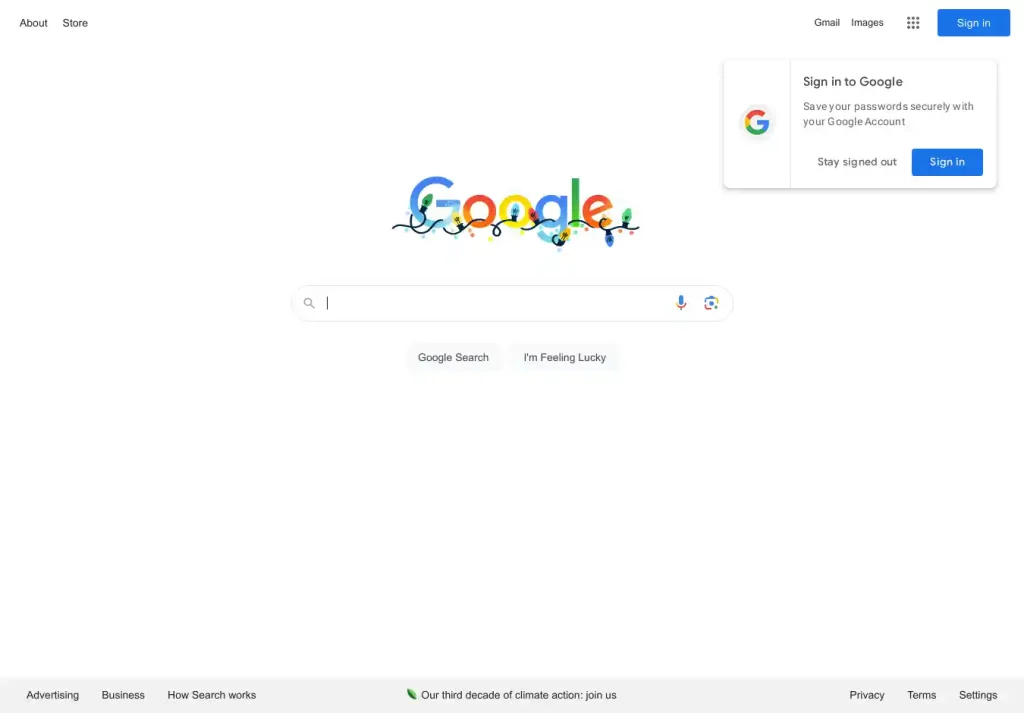
Google, as a frontrunner in the search engine market, generates colossal revenues through its advertising platform, Google Ads. With a global user base and a diverse array of ad formats, Google Ads has become synonymous with digital advertising. However, it’s crucial to note that while Google offers extensive reach, it does not prioritize privacy, potentially impacting user confidentiality.
Expanding on Google Ads, the platform has emerged as a dominant force in the digital advertising realm, significantly influencing the search engine marketing ecosystem. In 2022, Google’s revenue from advertising totaled a staggering $224.47 billion, showcasing a year-over-year increase despite being the slowest annual rise in over a decade. This upward trend continued into Q3 of 2023, with total worldwide revenue for Google reaching $76.7 billion, of which $59.6 billion was from Google advertising, including revenue from Google search, ads on YouTube, and the Google network. These figures represent a 9.5% year-over-year increase, highlighting the platform’s growing significance.
Google Ads’ impact on businesses is profound, with an estimated 80% of businesses globally using the platform for their Pay-per-Click (PPC) advertising needs. This preference is backed by impressive statistics: the platform connects with over 90% of internet users globally, and in the first two quarters of 2023, Google garnered $112.691 billion in ad revenue, which constituted 78% of its total revenue. With a dominant market share of 91.56% in the global search engine market, Google Ads’ reach is virtually unparalleled.
In terms of performance, Google Ads boasts an impressive return on investment (ROI), offering businesses $8 for every $1 spent. This efficiency is further demonstrated by the average conversion rate on Google Ads, which stands at 4.40% for its Search Network and 0.57% for its Display Network. Additionally, Google Ads’ Clickthrough Rate (CTR) averages between three percent and five percent, with the cost per click (CPC) ranging from $1-$2.
However, it’s important to note the potential privacy concerns associated with Google’s extensive reach and data collection methods. Despite its effectiveness in connecting brands with a vast online audience, Google’s advertising practices do not prioritize user privacy, which could be a significant consideration for some businesses and users.
For more detailed information and statistics on Google Ads, you can visit the sources at Oberlo and Techreport.
Snipesearch

At Snipesearch, we have adopted a unique approach with our Snipesearch Ad Clicks, focusing on privacy and minimal data retention. This reflects our commitment to user confidentiality. While this approach may not generate the same level of revenue as platforms like Google, we believe it is essential for building user trust and long-term engagement. Google Ads are used in filler spots in one of oour search engines, we minimise communication of end users data by passing the request through our servers and collecting the ads via an API. As part of our commitment to privacy. Google ads are not displayed on Any of our cloud search sites or independent index search portals, movie databases, hosting etc, and are typically only found doing a meta search on snipesearch.co.uk or snipesearch.net.
Revenue and Advertising Approach:
- Search Advertising Revenue: Here at Snipesearch, our advertising model is cost-effective. We offer a starting CPM (Cost Per Thousand Impressions) of $0.01, with an average CPM of $0.03. This pricing strategy is tailored to be accessible to a wide range of advertisers, including small and medium enterprises.
- Cost-Per-Click (CPC): At Snipesearch, we provide a starting CPC of $0.01, and as of the time of writing, our average CPC is $0.05. These competitive rates are designed to be attractive for advertisers who are conscious of their budget.
- Click Fraud Protection: We at Snipesearch are proud of our robust click fraud protection mechanisms. Impressively, we have had no reports of click fraud in the last six months, a testament to the effectiveness of our multifaceted fraud protection system.
- Ad Delivery: Our ads are delivered based on the content of the page or the keywords searched, ensuring that ads are relevant to users’ current interests without compromising their privacy.
- Language and Location Targeting: We use the language of the user’s browser or the page content for language targeting, a method that respects user privacy more than traditional location-based targeting.
Advantages of Our Business Model:
- Building User Trust: At Snipesearch, we do not collect sensitive personal data such as age, gender, income, or marital status, fostering a high level of user trust.
- Effective and Relevant Targeting: By targeting ads based on page content or search keywords, we ensure relevancy, potentially increasing engagement and conversion rates.
- Global Reach and Accessibility: Despite our focus on privacy, Snipesearch maintains significant global reach and accessibility, a testament to the effectiveness and user-friendliness of our search engine and advertising network, The snipe network served around 100 million requests Globally in 2023.
Challenges We Face:
- Revenue Limitations: Our commitment to privacy, although essential, might limit our ability to generate revenue on the same scale as more data-reliant networks.
- Market Positioning: In a market dominated by larger players, standing out while maintaining our privacy-first approach can be challenging.
In summary, at Snipesearch, we offer a unique balance in the digital advertising space. Our commitment to user privacy, combined with effective advertising solutions, positions us as a trustworthy and responsible player in the digital advertising ecosystem.
DuckDuckGo

DuckDuckGo, renowned for its privacy-centric approach to search, partners with Bing Ads to balance its commitment to user privacy with the need for revenue generation. This strategic alliance enables DuckDuckGo to maintain its core privacy values while benefiting from Bing’s extensive advertising network.
History and Evolution of DuckDuckGo:
- Foundation: DuckDuckGo was founded with the primary goal of providing an alternative search experience that respects user privacy. Over the years, it has become a beacon for users concerned about online privacy.
- Growth: The search engine has seen a steady increase in its user base, mainly due to growing concerns over privacy among internet users.
Advantages of DuckDuckGo:
- Privacy: DuckDuckGo doesn’t track user searches or personal data, making it a preferred choice for privacy-conscious users.
- Unbiased Search Results: The absence of personalized search history ensures unbiased and unfiltered search results.
- User Experience: The search engine offers a clean, ad-free user interface, which is appreciated by its users.
Disadvantages of DuckDuckGo:
- Limited Personalization: Due to its privacy focus, DuckDuckGo lacks the personalized search capabilities of other major search engines.
- Smaller Index: Compared to giants like Google, DuckDuckGo has a smaller search index, which can sometimes lead to less comprehensive search results.
Integration with Bing Ads:
- Revenue Generation: By leveraging Bing Ads, DuckDuckGo can offer advertising spaces while preserving user privacy. This is a critical revenue stream for the search engine.
- Global Reach: Bing Ads has a considerable global presence, allowing advertisers on DuckDuckGo to reach a wide audience.
Addressing Privacy Concerns:
- Privacy vs. Advertising: Utilizing Bing Ads raises questions about how DuckDuckGo balances user privacy with ad targeting. The key lies in the way DuckDuckGo handles user data – it doesn’t store or share personal information, ensuring privacy even when serving ads from Bing.
- Transparency: DuckDuckGo maintains transparency about its use of Bing Ads and how it impacts user privacy.
Why Consider DuckDuckGo for Website Indexing and Advertising:
- Target Privacy-Conscious Users: Advertising on DuckDuckGo through Bing Ads allows businesses to reach a niche market of privacy-conscious users.
- Diverse Audience Reach: Bing’s network, coupled with DuckDuckGo’s unique user base, provides a diverse audience reach.
- Cost-Effectiveness: Advertising on DuckDuckGo can be more cost-effective compared to larger networks, offering a good ROI for businesses.
In conclusion, DuckDuckGo’s partnership with Bing Ads creates a unique niche in the search engine market. It offers a compelling choice for users and advertisers alike, balancing privacy concerns with the need for effective digital marketing strategies. This balance makes DuckDuckGo an attractive option for businesses looking to reach a diverse and privacy-focused audience.
ExactSeek
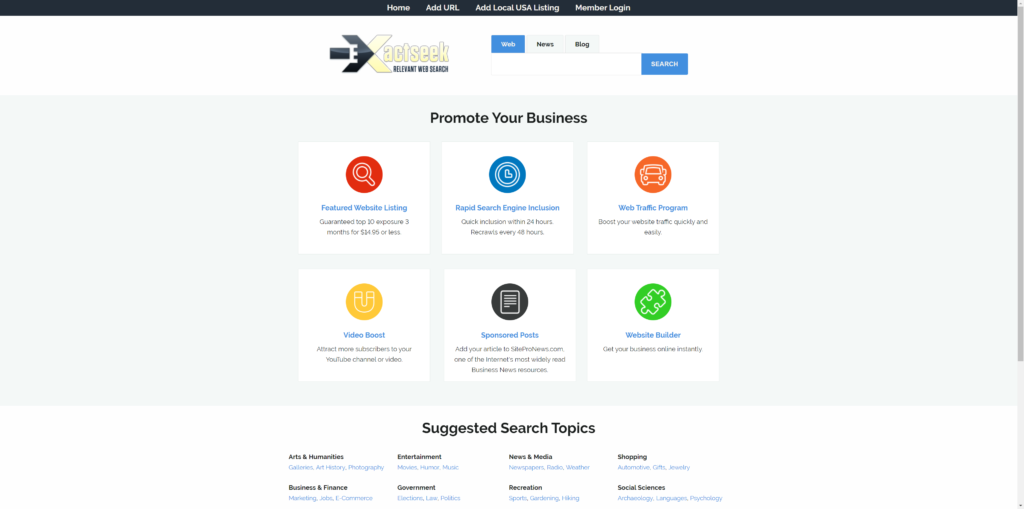
ExactSeek offers a unique approach in the search engine market with its Featured Website Listings, providing a distinctive revenue model through paid listings. This strategy caters to businesses seeking targeted visibility on ExactSeek’s platform. The service stands out for its affordability and quick inclusion of listings, offering an alternative to traditional search engine optimization methods.
Cost-Effective Keyword Targeting The cost structure of ExactSeek’s Featured Website Listings is designed to be budget-friendly. For a 3-month term, one keyword costs $12, and there’s an option to lock in a 12-month term for $44.95, offering substantial savings. This pricing strategy makes it accessible for small and medium-sized businesses to gain visibility without a significant financial commitment.
Rapid Inclusion in Search Results A notable feature of ExactSeek is the quick inclusion of featured listings. Listings are added within 6 to 8 hours to ExactSeek’s network, ensuring prompt visibility for advertisers. This rapid inclusion is crucial for businesses seeking immediate exposure and can be particularly beneficial for time-sensitive promotions or launches.
Equitable Rotation System ExactSeek employs a rotation system for its listings, giving each advertisement an equal opportunity to appear at the top of the search results for the chosen keyword phrase. This system ensures fairness and equal visibility for all advertisers, regardless of their budget size, making it an attractive option for businesses of all scales.
User Feedback and Experiences Feedback from users highlights the effectiveness and satisfaction with ExactSeek’s services. According to a review on Trustpilot, a user appreciated the feature listing option, priced at $14.00 every three months, with the listing being active and online promptly. Another user, as per Small Website Hosting, found value in buying a keyword for a 3-month term at $12, which included various bonuses like an SEO ebook. These testimonials underscore the practical benefits and user satisfaction with ExactSeek’s Featured Website Listings.
Other Notable Features ExactSeek’s Featured Website Listings are not just about quick inclusion and affordable pricing. The service offers discounts for bulk purchases, making it an even more cost-effective option for businesses planning to target multiple keywords or run extensive campaigns.
Listing Guidelines and Practices According to ExactSeek.com, the number of listings that can be purchased is limited, ensuring that the system is not overloaded and each ad gets fair exposure. This policy of limiting and rotating listings ensures that each advertisement is treated equally, contributing to a balanced and effective advertising ecosystem.
For more detailed information and user experiences, you can visit the official websites:
- Trustpilot Review of ExactSeek
- Small Website Hosting Review of ExactSeek
- ExactSeek Store Information
- ExactSeek.com Help and Guidelines
ExactSeek’s Featured Website Listings offer a unique and effective way for businesses to gain visibility on its search platform. Its combination of affordability, rapid inclusion, and equitable ad rotation make it a compelling choice for advertisers seeking targeted exposure without the complexities and costs typically associated with traditional search engine marketing.
DogPile
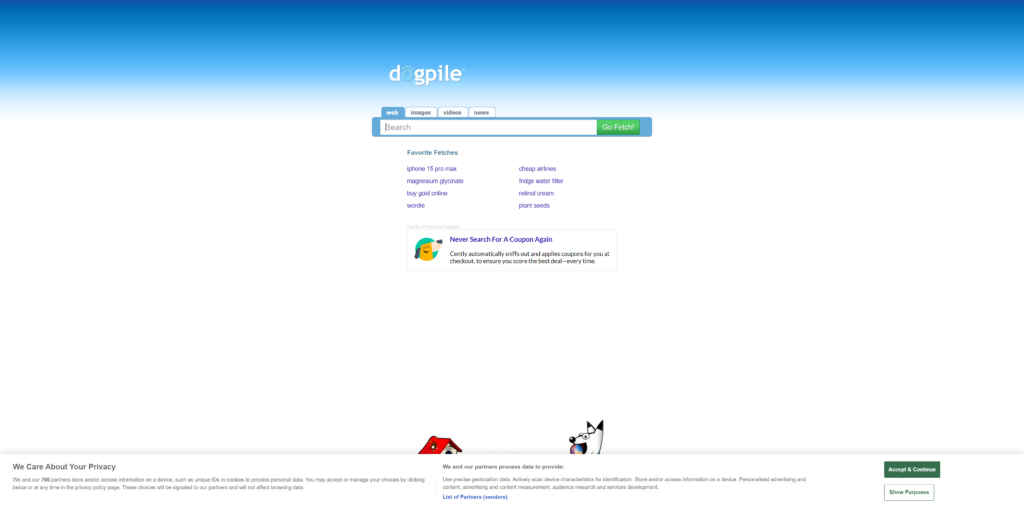
Dogpile, a meta-search engine, stands out in the search engine landscape by aggregating results from multiple search platforms, including Google, Yahoo, and Bing. This unique approach allows Dogpile to offer users a comprehensive search experience, drawing from a wide array of sources to deliver diverse and extensive results. The platform generates revenue primarily through Bing Ads, integrating this advertising network’s capabilities into its service.
Global Traffic Reach and User Privacy Dogpile’s ability to amalgamate results from various search engines translates into a broad global reach. It can cater to a wide demographic, offering users a one-stop solution for diverse search results. However, the incorporation of Bing Ads raises concerns about user privacy. Unlike search engines like DuckDuckGo or Snipesearch that prioritize user privacy, Dogpile’s reliance on Bing Ads means that users’ data may be subject to Bing’s data collection and usage policies. This aspect might be a consideration for privacy-conscious users when choosing Dogpile as their search engine.
History and Evolution of Dogpile Founded in 1996, Dogpile started as a standalone search engine before transitioning into a meta-search engine. Over the years, Dogpile has evolved to include features like category links, recent searches, and a favorites list, enhancing user experience. Its “Search Spy” feature, which displays real-time search queries, was an innovative offering, although it raised privacy concerns.
Advantages and Disadvantages One of Dogpile’s main advantages is its comprehensive search results, derived from combining multiple search engines. This feature ensures users receive a well-rounded view of the web, reducing the likelihood of missing relevant information. However, Dogpile’s reliance on Bing Ads as its primary revenue source means that the search experience can be interspersed with advertisements, potentially affecting the user experience.
Bing Partner Network and Advertising Opportunities Advertising on Dogpile through the Bing Partner Network offers businesses the opportunity to reach a wider audience. Since Dogpile collates results from various search engines, ads placed through Bing Ads have the potential to be displayed more broadly than on Bing alone. This expanded reach can be advantageous for businesses looking to increase their visibility across multiple platforms with a single advertising campaign.
Dogpile’s unique approach to search aggregation, combined with its integration with Bing Ads, offers a distinct experience in the search engine market. While it provides comprehensive search results, users and advertisers must weigh the benefits of its extensive reach against the potential privacy concerns associated with Bing Ads. For advertisers, Dogpile presents an opportunity to leverage the broad visibility of Bing’s network, potentially increasing the effectiveness of their digital marketing efforts.
Yandex

Yandex, established in 1997, swiftly emerged as the premier search engine in Russia, commanding significant influence in the digital landscape of Russia and its neighboring countries. Recognized for its sophisticated understanding of the Russian language and culture, Yandex provides highly relevant search results, making it a pivotal player in the region’s internet ecosystem.
Global Reach and Market Presence: Yandex’s dominance is most pronounced in Russia, where it surpasses other global search engines. It also has a substantial presence in Belarus, Kazakhstan, Ukraine, and Turkey. While its primary audience is Russian-speaking, its global reach extends to Russian expatriates and those interested in the region’s content.
History and Evolution of Yandex: Yandex started as a mere search engine but rapidly expanded into an internet conglomerate offering a wide range of services like Yandex.Maps, Yandex.Music, Yandex.Taxi, and even cloud solutions. Its growth reflects a deep understanding of the local market, adapting and innovating to meet the diverse needs of its users.
Advantages of Yandex:
- Localized Expertise: Superior understanding of Russian linguistics and local preferences.
- Diverse Services: Wide array of services under the Yandex umbrella, providing various platforms for content and advertising.
- Customization and Innovation: Continuously evolving to introduce new features and services tailored to its user base.
Disadvantages of Yandex:
- Regional Concentration: Its primary focus is on Russian-speaking regions, which may not be ideal for global campaigns.
- Language Barrier: Non-Russian advertisers may find it challenging to navigate and utilize Yandex’s full capabilities.
Privacy Policy: Yandex’s approach to user privacy is a critical aspect, especially considering Russia’s internet regulations. While Yandex collects user data for personalized experiences and ad targeting, it adheres to legal standards and offers users control over their data. However, concerns about government surveillance and data access remain prevalent.
Why Advertise with Yandex?
- Targeted Reach: Yandex offers an unparalleled opportunity to reach the vast Russian-speaking market.
- Diverse Advertising Solutions: With Yandex.Direct, advertisers can leverage a variety of ad formats and placements across Yandex’s extensive network.
- Cost-Effectiveness: Yandex provides a competitive and budget-friendly advertising environment compared to other global players.
Yandex’s Strategic Value
Yandex, with its deep-rooted presence in the Russian internet space, offers unique advantages for businesses targeting this specific audience. Its comprehensive understanding of local trends, user behavior, and language nuances makes it an indispensable platform for advertisers looking to penetrate the Russian market. While its focus remains regional, its impact and relevance extend beyond, offering a distinctive approach to digital marketing in a diverse and dynamic online landscape.
Gibiru
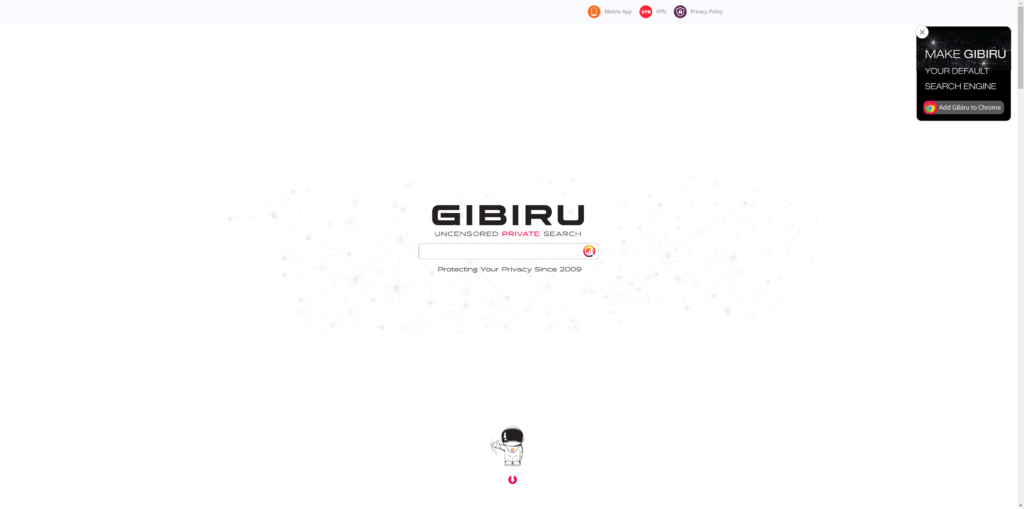
Gibiru, established with the mission to provide uncensored and private search experiences, stands out in the realm of search engines. It’s known for its commitment to offering unbiased search results without tracking user activity. Gibiru positions itself as a champion of internet freedom, catering to users who prioritize privacy and uncensored information.
Global Traffic Reach and Market Impact: While Gibiru is not as widely recognized as its mainstream counterparts, it has carved out a niche audience who value privacy above all. This audience, though smaller in size compared to giants like Google, is highly engaged and loyal, making Gibiru an attractive platform for certain advertisers.
Contradiction with Google Ads: The use of Google Ads by Gibiru might seem antithetical to its privacy promise. Google Ads, known for its extensive user tracking and profiling capabilities, offers a level of market reach and ad relevance that is hard to match. This paradox highlights the challenges faced by smaller search engines in balancing privacy commitments with commercial viability.
Addressing Privacy Concerns: Users who are drawn to Gibiru for its privacy features might be wary of the integration with Google Ads. It’s essential for Gibiru to transparently communicate how it maintains user privacy while utilizing Google Ads. This includes clarifying whether any user data is shared with Google and outlining the steps taken to protect user anonymity.
Advantages of Gibiru:
- Uncensored Content: Access to unfiltered search results.
- Privacy-Centric: No tracking of user search history or personal data.
- Niche Audience: Appeals to users highly concerned about online privacy and censorship.
Disadvantages of Gibiru:
- Limited Reach: Smaller user base compared to mainstream search engines.
- Google Ads Paradox: Potential conflict with privacy values.
- Lesser-Known: Lower brand recognition and trust compared to established players.
Why Advertise on Gibiru through Google Ads?
- Targeted Niche: Reach a specific audience deeply concerned about privacy and censorship.
- Content Freedom: Opportunity to advertise content that might be restricted on other platforms.
- Google’s Network: Leverage the power of Google’s ad network for wider reach and advanced targeting, despite potential privacy concerns.
Gibiru’s Unique Position
Gibiru’s utilization of Google Ads reflects the complex dynamics of the search engine market, where privacy-focused platforms must navigate the realities of digital advertising. While this may raise questions about privacy integrity, it also opens doors for advertisers seeking a unique and engaged audience. Gibiru remains an intriguing option for both users and advertisers, balancing uncensored content access with the broad capabilities of Google’s advertising network.
Qwant
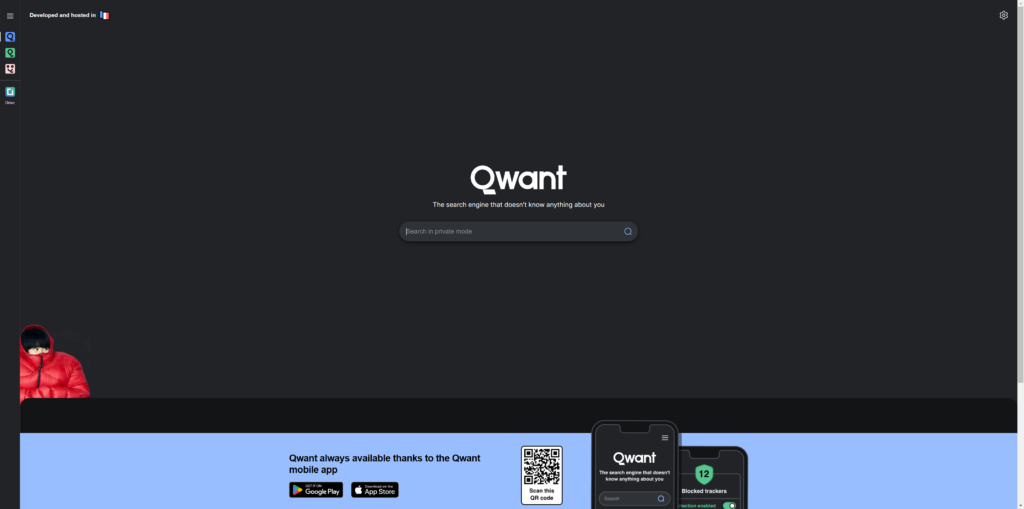
Qwant, a search engine that prides itself on respecting user privacy, has made significant strides in offering uncensored and unbiased search results. Unlike mainstream search engines, Qwant doesn’t track user searches or create personal profiles for targeted advertising, appealing to users who prioritize data privacy.
Global Traffic Reach and Market Positioning: Qwant, while not as universally known as Google or Bing, has gained a dedicated user base, especially among privacy-conscious individuals in Europe. This focused market segment, though smaller, is particularly valuable for advertisers targeting privacy-minded consumers.
Integrating with Google Ads: Qwant’s use of Google Ads might appear at odds with its privacy-first philosophy. Google Ads, with its extensive user tracking capabilities, offers unparalleled market reach and ad targeting efficiency. This integration reflects the complex balance smaller search engines must strike between maintaining privacy commitments and ensuring financial sustainability.
Addressing Privacy with Google Ads: Qwant’s challenge lies in clearly communicating to its users how it continues to uphold privacy standards while using Google Ads. It’s crucial for Qwant to be transparent about its data handling practices with Google Ads, ensuring users that their search privacy remains uncompromised.
Advantages of Qwant:
- Privacy Assurance: No tracking of personal search data.
- Unbiased Searches: Neutral search results without personalization.
- Growing Popularity: Especially among European users who value privacy.
Disadvantages of Qwant:
- Limited Reach: Smaller audience compared to global search engines.
- Potential Privacy Paradox: Use of Google Ads could be seen as conflicting with its privacy ethos.
- Lower Brand Recognition: Compared to industry giants like Google or Bing.
Why Opt for Qwant and Google Ads?
- Privacy-Sensitive Audience: Attract users who value privacy but are still reachable through Google’s extensive ad network.
- Focused Market: Ideal for brands and services that align with privacy values and European markets.
- Utilizing Google’s Strength: Despite privacy concerns, leveraging Google’s ad targeting and reach capabilities.
Qwant’s Privacy-Advertising Balancing Act
Qwant’s decision to use Google Ads highlights the intricacies of the search engine market where privacy-focused platforms must contend with the realities of the digital advertising ecosystem. While this might raise eyebrows among privacy advocates, it also presents a unique opportunity for advertisers to tap into a market segment that is typically hard to reach. Qwant stands as an interesting player in the search engine landscape, striving to provide private and unbiased search experiences while navigating the competitive world of digital advertising.
Startpage
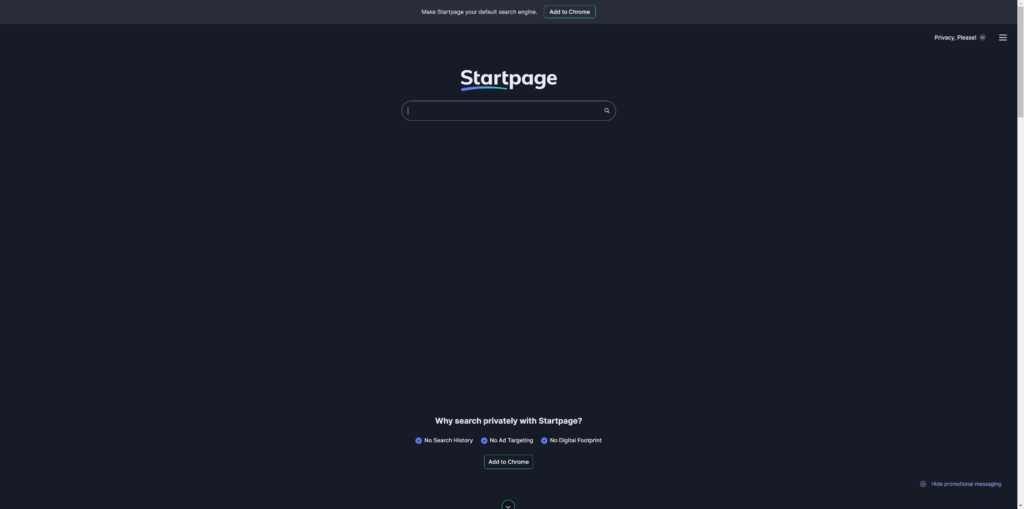
Startpage has emerged as a notable player in the search engine market, distinguishing itself through a steadfast commitment to user privacy. The platform is designed to offer private, uncensored search experiences without tracking or storing user data. This approach has garnered attention from privacy-conscious internet users globally.
Global Traffic Reach and Market Impact: While Startpage does not boast the same user numbers as giants like Google, it holds a significant position in the niche market of privacy-focused search engines. Its user base, though smaller, is dedicated and growing, especially among those disillusioned with mainstream search engines’ data practices.
Collaboration with Google Ads: Startpage’s use of Google Ads is a strategic move to generate revenue while maintaining a high-quality search service. This partnership allows Startpage to benefit from Google’s extensive ad network, although it seemingly contrasts with its privacy-centric model.
Privacy Concerns with Google Ads: The use of Google Ads on a platform that promotes privacy raises questions about user data handling. Startpage must assure its users that despite this partnership, their search data remains private and is not used for targeted advertising by Google.
History of Startpage: Startpage was born out of a desire to provide an alternative to data-driven search engines. It started as a small venture but has since grown into a respected name among privacy-focused web services, consistently advocating for internet privacy and neutrality.
Advantages of Using Startpage:
- Commitment to Privacy: Ensures user searches are private and anonymous.
- No Tracking: Does not store personal data or search history.
- Google’s Search Power: Offers quality search results leveraging Google’s search technology.
Disadvantages of Using Startpage:
- Limited Audience Reach: Compared to major search engines.
- Ad Paradox: Utilizes Google ads, which may be seen as contrary to its privacy promise.
- Less Brand Recognition: In the shadow of larger search engines.
Why Choose Startpage for Advertising:
- Privacy-Conscious Audience: Attract users who value privacy but are still reachable through Google Ads.
- Focused Demographic: Ideal for targeting users skeptical of mainstream search engines.
- Balancing Privacy with Reach: Access to Google’s advertising capabilities while offering private search experiences.
Startpage’s Delicate Balance
Startpage stands at the intersection of privacy advocacy and the realities of digital advertising. Its decision to partner with Google Ads is a pragmatic approach to sustain its services while navigating the complex digital advertising landscape. For advertisers, Startpage offers a unique opportunity to reach a specific segment of privacy-aware users, leveraging the prowess of Google’s ad network. This collaboration, while paradoxical, underscores the challenges and possibilities in the contemporary search engine market, where privacy considerations and economic viability are constantly balanced.
Privacy Considerations in Ad Networks

In the realm of digital advertising, the tension between maintaining user privacy and leveraging ad networks for reach is a pivotal issue. The landscape is marked by contrasting approaches: on one side are traditional ad networks like Google Ads and Bing Ads, known for their extensive data usage, and on the other are privacy-focused platforms like Snipesearch Ad Clicks and a-ads, which prioritize minimal data retention.
The Traditional Approach: Google Ads and Bing Ads
- Sophisticated Targeting: These networks collect and analyze extensive user data to deliver highly targeted ads.
- Global Reach: Their large user bases ensure advertisements have maximum visibility.
- Privacy Trade-offs: The comprehensive data collection methods raise concerns about user privacy and data security.
The Privacy-Centric Approach: Snipesearch Ad Clicks and a-ads
- Minimal Data Retention: These platforms limit data collection, storing only essential information for ad delivery.
- User Privacy: They respect user confidentiality, appealing to an audience sensitive about their online footprint.
- Targeting Limitations: While they offer a safer space for users, the reduced data use may lead to less precise ad targeting.
A Balancing Act: Reach vs. Privacy Platforms must navigate the fine line between effective reach and respecting user privacy. Traditional networks offer powerful targeting but at the potential cost of user trust. Privacy-centric networks, while appealing to privacy-conscious users, may face limitations in ad personalization and reach.
Conclusion: The Future of Search Engine Marketing The diversity in the search engine marketing ecosystem reflects the varying needs and priorities of users and advertisers. Platforms like Google Ads dominate in terms of reach and sophistication, but privacy-centric alternatives like Snipesearch Ad Clicks are carving out their own space, appealing to a growing segment of privacy-aware users.
As part of the Snipesearch team, our commitment to balancing user privacy with effective advertising remains central to our mission. We believe this equilibrium is not just desirable but essential in an age where digital privacy concerns are escalating. Our goal is to offer an advertising experience that respects user privacy while still delivering substantial value to our advertisers. This commitment to balance and respect for user preferences will continue to guide us in the dynamic and diverse landscape of search engine marketing.
Section 3: The Value of Paid Advertisements

Understanding the Investment in Paid Advertisements
Businesses of all sizes turn to paid advertisements on search networks for a multitude of reasons. In a digital age where visibility is key, paid ads offer a direct and impactful way to reach potential customers. Unlike organic search, which depends on the ever-changing algorithms of search engines, paid ads provide a more controlled and predictable means of gaining visibility.
Strategic Visibility:
- Immediate Impact: Paid ads offer immediate placement at the top of search engine results pages (SERPs), bypassing the need to organically climb the rankings.
- Targeted Reach: Advertisers can target specific demographics, geographies, and even user behaviors, ensuring that their ads reach the most relevant audience.
Algorithm-Proof Marketing:
- Guarding Against Changes: Search engine algorithms are notoriously fluid, often changing without notice. This unpredictability can dramatically affect organic search results. Paid ads, however, remain largely unaffected by these changes.
- Consistency and Control: With paid ads, businesses have greater control over their message and how it’s delivered, regardless of organic search algorithm updates.
Case Studies: Paid Advertisement Success Stories
Case Study 1: Small Business Growth Through Targeted Ads
- Background: A small, local bakery started using paid ads to increase its visibility within its city.
- Strategy: The bakery targeted local customers with ads showcasing daily specials and seasonal offers.
- Outcome: The campaign led to a 40% increase in foot traffic and a significant boost in online orders. The bakery also saw an uptick in social media followers and engagement, attributed to the increased brand visibility from the ads.
Case Study 2: E-commerce Brand Expansion
- Background: An online retailer specializing in sustainable home goods turned to paid ads to broaden its market reach.
- Strategy: By using a combination of search and display ads, the retailer targeted environmentally-conscious consumers across the country.
- Outcome: The paid ad campaign resulted in a 60% increase in website traffic and a 30% rise in sales over six months. Customer engagement and repeat purchases also increased, contributing to sustained business growth.
Case Study 3: B2B Lead Generation
- Background: A software company offering project management tools implemented a paid ad strategy to generate more B2B leads.
- Strategy: The company used LinkedIn ads to target professionals and decision-makers in relevant industries.
- Outcome: The targeted approach led to a 50% increase in qualified leads, with a significant number converting into long-term contracts. The campaign also enhanced brand recognition in the professional community.
Paid advertisements on search networks are a valuable asset for businesses looking to gain quick, targeted visibility and shield themselves from the uncertainties of search engine algorithm changes. These case studies illustrate the potential of paid ads to drive business growth, enhance brand recognition, and generate valuable leads. As search engines continue to evolve, the role of paid advertisements will remain a cornerstone of effective digital marketing strategies.
Section 4: SEO and Budget Efficiency
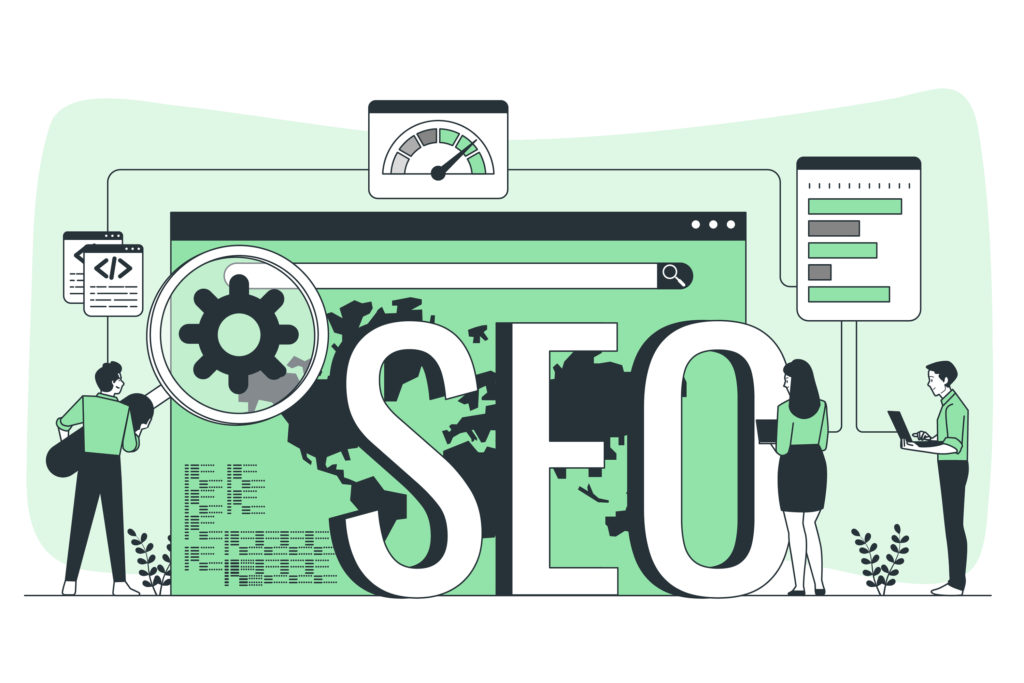
In the intricate world of digital marketing, effective Search Engine Optimization (SEO) strategies stand as crucial components for businesses seeking cost-effective marketing solutions. SEO, the practice of optimizing web content to rank higher in search engine results, offers a sustainable and budget-friendly approach to increasing a brand’s visibility and reach.
Strategic Cost Reduction Through SEO
- Long-term Investment: Unlike paid advertisements, which require ongoing funding to maintain visibility, the effects of a well-executed SEO strategy can endure long after the initial investment. This longevity provides businesses with an enduring online presence without continual spending.
- Organic Reach: SEO focuses on enhancing a website’s visibility organically, attracting a consistent flow of traffic without the costs associated with pay-per-click (PPC) models.
- Building Brand Credibility: High rankings in search results inherently boost a brand’s credibility, often translating to higher trust and engagement from potential customers. This organic trust-building is a cost-effective alternative to paid branding campaigns.
SEO and Long-term Cost Savings
- Sustainable Growth: Proper SEO leads to a gradual increase in website traffic and user engagement. This growth compounds over time, potentially reducing the need for expensive short-term marketing tactics.
- Reduced Dependence on Paid Ads: As a website’s organic ranking improves, its reliance on paid advertising can decrease, leading to significant cost savings.
- Increased ROI: SEO can provide an impressive return on investment (ROI) as the initial costs are often offset by the value of sustained organic traffic and conversions.
Real-world Examples of SEO-Driven Cost Efficiency
Case Study 1: E-commerce Website
- Background: An online retailer specializing in handmade crafts struggled with high advertising costs.
- Strategy: The company revamped its website with SEO-friendly content, focusing on long-tail keywords and user experience improvements.
- Outcome: Within a year, the site saw a 300% increase in organic traffic and a 50% decrease in ad spend. The improved organic reach allowed for a reduced reliance on costly PPC campaigns.
Case Study 2: Local Service Provider
- Background: A local plumbing business was seeking to increase its local customer base without a large marketing budget.
- Strategy: The business implemented local SEO strategies, optimizing for geo-specific keywords and creating local business listings.
- Outcome: The business experienced a 200% increase in local inquiries and was able to scale back its advertising budget by 70% due to the effectiveness of its SEO efforts.
Case Study 3: B2B Tech Startup
- Background: A B2B tech startup faced fierce competition in the market and needed to establish a solid online presence.
- Strategy: The startup focused on creating high-quality, SEO-optimized content that addressed specific pain points in its industry.
- Outcome: The startup’s website began ranking for several competitive keywords, leading to increased organic traffic and a significant reduction in the need for paid promotional activities.
SEO emerges as a vital tool for businesses aiming to establish a sustainable online presence while managing marketing expenses efficiently. By investing in SEO, companies can enjoy the dual benefits of reducing their marketing budget and achieving long-term, organic growth. These real-world examples underscore the importance of SEO in crafting a cost-effective, high-impact marketing strategy that delivers lasting results.
Section 5: Ad Placement and Search Result Dynamics

In the dynamic world of digital marketing, the strategic placement of advertisements in relation to search engine results plays a pivotal role. This placement directly influences user interaction and engagement, making it a critical factor for advertisers and marketers to consider.
Strategic Importance of Ad Placement
- Visibility and Attention: The placement of ads on a search engine results page (SERP) is crucial. Ads positioned at the top or within the first few results often receive the highest visibility and, consequently, more clicks.
- User Intent and Relevance: Ads that align with the user’s search intent and are placed in relevant sections of the SERP tend to perform better. This relevance ensures that the ads are not only seen but also engaged with.
- Competitive Advantage: Effective ad placement can give businesses a competitive edge, particularly in highly saturated markets. Ads that are prominently displayed can overshadow organic search results, capturing user attention first.
Influence of Ad Location on User Interaction
- Top vs. Bottom Placement: Ads at the top of the SERP generally achieve higher click-through rates (CTR) than those at the bottom. Users are more likely to engage with what they see first, especially if it matches their search query.
- Side Panel Ads: Ads placed on the side panels of a SERP can be effective for certain types of products or services, especially when they include visual elements. However, they might be overlooked if users are focused solely on the central list of search results.
- Mobile vs. Desktop Variations: The impact of ad placement also varies between mobile and desktop devices. On mobile devices, where screen space is limited, top-placed ads are even more crucial.
Search Engine Algorithms and Ad Visibility
- Algorithm Influence: Search engines use complex algorithms to determine which ads to display for a given query. These algorithms consider factors such as ad relevance, keyword matching, and the advertiser’s bid amount.
- Quality Score: Many search engines assign a quality score to ads, impacting their placement. A higher quality score, indicating more relevance and better user experience, can lead to better ad positions and lower costs.
- Dynamic Nature: Search engine algorithms are continually evolving, which can affect ad placement strategies. Advertisers must stay updated with these changes to ensure their ads remain visible and effective.
The placement of ads in search results is not just about securing a spot on the SERP. It’s about strategically positioning these ads to maximize visibility, align with user intent, and outshine the competition. The delicate balance between the ad’s location, the user’s needs, and the ever-evolving search engine algorithms forms the crux of successful digital advertising. Understanding and leveraging this interplay is essential for businesses looking to optimize their online advertising efforts and achieve maximum return on investment.
Section 6: Snipesearch Adclick – A Case Study
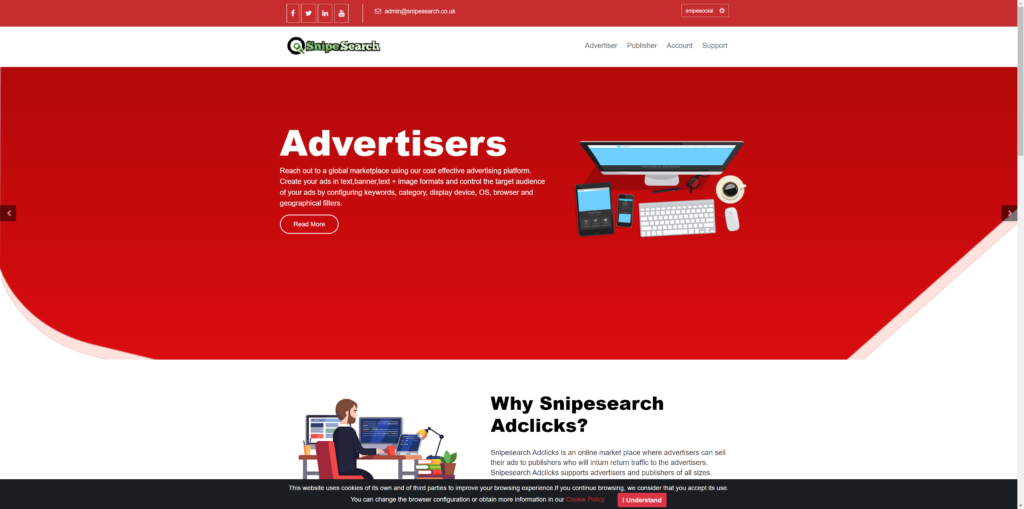
In the expansive realm of search engine marketing (SEM), Snipesearch Adclick emerges as a distinctive player, offering a unique approach to digital advertising. This section delves into an in-depth analysis of Snipesearch Adclick, comparing it with established networks like Google Ads, Bing Ads, and A-ads, and highlighting its advantages in a diverse SEM strategy.
Unique Positioning of Snipesearch Adclick
- Privacy-Centric Approach: Unlike many mainstream ad networks, Snipesearch Adclick emphasizes user privacy, eschewing extensive data collection for ad targeting. This approach aligns with the growing global concern for digital privacy.
- Focused Ad Delivery: Snipesearch Adclick leverages contextual and keyword-based targeting rather than user profiling, ensuring relevant ad placement without infringing on user privacy.
- User Trust and Engagement: By prioritizing privacy, Snipesearch Adclick builds trust with its user base, fostering higher engagement rates and loyalty. This trust is a critical asset in the increasingly privacy-aware online landscape.
Comparative Analysis with Other Ad Networks
- Google Ads and Bing Ads: These platforms are known for their extensive reach and sophisticated targeting capabilities, driven by detailed user data. While effective, their approach raises privacy concerns.
- A-ads: Similar to Snipesearch Adclick, A-ads offers privacy-focused advertising. However, it primarily caters to cryptocurrency-related content, limiting its scope compared to Snipesearch Adclick’s broader market appeal.
- Cost-Effectiveness and Reach: Snipesearch Adclick’s competitive pricing structure, starting with a CPM of $0.01 and an average CPC of $0.05, makes it an accessible option for diverse businesses. In contrast, Google Ads and Bing Ads often have higher costs, albeit with potentially broader reach.
- Click Fraud Mitigation: Snipesearch Adclick’s vigilant approach to click fraud, with no reported incidents in the last six months, contrasts with the more prevalent click fraud issues on larger networks.
Advantages in a Diverse SEM Strategy
- Balancing Privacy and Reach: Snipesearch Adclick offers a middle ground for advertisers seeking to balance user privacy with effective ad placement. This balance is particularly appealing in sectors where privacy is paramount.
- Complementing Other Networks: By incorporating Snipesearch Adclick into a broader SEM strategy, businesses can leverage its unique strengths while also benefiting from the extensive reach of platforms like Google Ads.
- Niche Targeting: For content and products that align closely with Snipesearch’s user base, the platform can provide highly effective targeting, reaching an audience that is engaged and interested in privacy-focused content.
Snipesearch Adclick stands out in the SEM ecosystem with its commitment to user privacy and efficient, context-based ad targeting. This distinctive approach offers a compelling alternative or complement to larger, more data-intensive ad networks. For businesses crafting a nuanced SEM strategy, integrating a platform like Snipesearch Adclick can yield significant benefits, balancing reach, cost-effectiveness, and user trust. As digital advertising continues to evolve, the role of privacy-centric platforms like Snipesearch Adclick will likely become increasingly vital in the diverse tapestry of online marketing.
Section 7: Privacy Concerns and Ad Networks

In the digital age, where data is as valuable as currency, the interplay between privacy concerns and ad networks presents a complex paradox, especially for privacy-led search engines. This section explores the implications of privacy-led search engines using major ad networks like Google and Bing and compares them with privacy-centric networks like A-ads and Snipesearch Adclicks.
The Paradox of Privacy-Led Search Engines and Major Ad Networks
- Privacy vs. Monetization: Privacy-led search engines face a conundrum. While their primary appeal is protecting user privacy, they also need to monetize their platforms, often leading them to partner with large ad networks known for extensive data collection.
- User Expectations: Users flock to privacy-led search engines with the expectation of enhanced privacy protection. The use of major ad networks, which often track user behavior, can be seen as a betrayal of these expectations.
- Balancing Act: These search engines must navigate the delicate balance of maintaining user trust while ensuring financial sustainability. How they manage this balance is crucial to their long-term success and user retention.
Implications of Ad Network Choices on User Privacy
- Data Collection Practices: Major ad networks like Google and Bing gather vast amounts of user data for targeted advertising. This practice stands in stark contrast to the ethos of privacy-led search engines.
- Potential Privacy Breaches: The association with major ad networks can expose users of privacy-led search engines to potential privacy breaches and data tracking, undermining the core value proposition of these platforms.
- Transparency and User Choice: It becomes essential for privacy-led search engines to be transparent about their ad partnerships and provide users with clear choices regarding data collection and ad targeting.
Comparative Look at Privacy-Centric Ad Networks
- A-ads: Known for its focus on cryptocurrency-related content, A-ads offers minimal data collection for ad targeting. This approach aligns with the privacy preferences of its user base but may limit its appeal to a broader audience.
- Snipesearch Adclicks: Snipesearch Adclicks presents a more generalist approach to privacy-centric advertising. By focusing on contextual and keyword-based targeting, it avoids invasive user tracking while still providing effective ad placements.
- Advantages of Privacy-Centric Networks: Networks like A-ads and Snipesearch Adclicks cater to a growing segment of users and advertisers who prioritize privacy. They offer a viable alternative to traditional ad networks, especially in niches where privacy is a key concern.
- Market Reach vs. Privacy: While privacy-centric networks may not match the reach of giants like Google and Bing, they offer a more ethical approach to advertising, which can be a significant draw for certain demographics and sectors.
The intersection of privacy concerns and ad network choices is a defining issue for modern search engines, especially those that position themselves as champions of user privacy. While the lure of partnering with major ad networks for financial gains is strong, it is crucial for these platforms to remain true to their privacy commitments. Privacy-centric ad networks like A-ads and Snipesearch Adclicks illustrate that it is possible to create a sustainable business model without compromising on user privacy. As the digital landscape evolves, the choices made by search engines in this regard will significantly impact their credibility, user trust, and market position.
Section 8: Comprehensive Market Analysis

This section delves into the global search market, offering insights into its size, prevailing trends, and future forecasts. It also breaks down the global advertising market into its various sectors, with a special focus on digital advertising. Additionally, it explores the role of factors like speed, accessibility, and user considerations in shaping the search market landscape.
Global Search Market: Size, Trends, and Predictions
- Market Size and Growth: The global search market has witnessed exponential growth over the past decade, driven by increasing internet penetration and mobile device usage. This growth trend is expected to continue, with emerging markets playing a pivotal role.
- Evolving Search Trends: With advancements in AI and machine learning, search engines are becoming more sophisticated in understanding user intent. Voice search and visual search are emerging trends that are redefining how users interact with search engines.
- Future Predictions: The search market is likely to see increased personalization, integration with IoT devices, and greater emphasis on privacy and security. Emerging technologies like blockchain could further revolutionize the search experience.
Global Advertising Market: Digital Focus and Sector Breakdown
- Shift to Digital: The advertising market has witnessed a significant shift from traditional mediums to digital platforms. This transition has been accelerated by the pandemic, leading to increased spends on digital advertising.
- Sector Breakdown: Digital advertising encompasses various formats, including display ads, search ads, social media ads, and video ads. Each format caters to different objectives and target audiences, making the market diverse and dynamic.
- Innovations and Trends: Programmatic advertising, augmented reality (AR) ads, and interactive ads are some of the innovative trends reshaping digital advertising. These technologies offer immersive experiences and improved engagement rates.
Influencing Factors: Speed, Accessibility, and User Considerations
- Speed and Efficiency: In the fast-paced digital world, the speed of delivering search results and ads is crucial. Faster load times and efficient ad delivery systems enhance user experience and engagement.
- Accessibility: The ease of accessing search engines and ads, especially on mobile devices, greatly influences user preferences. Search engines that optimize for mobile accessibility tend to have higher engagement.
- User Considerations: User behavior and preferences significantly shape the search market. Factors like privacy concerns, ad fatigue, and demand for relevant content drive innovations and changes in search algorithms and advertising strategies.
The global search and advertising markets are dynamic and ever-evolving, influenced by technological advancements, user behavior, and market trends. As we look towards the future, the intersection of these factors will continue to shape the trajectory of these markets. The emphasis on privacy, personalization, and mobile accessibility will likely dominate the strategies of key players in the search and advertising realms. Understanding these trends and their implications is crucial for businesses and marketers looking to navigate this complex and competitive landscape effectively.
Conclusion
As we reach the culmination of our exploration of the search engine marketing (SEM) ecosystem, it becomes clear that this landscape is as vast as it is dynamic. It’s a realm where technology, user behavior, privacy concerns, and business objectives intersect, creating a tapestry of challenges and opportunities for advertisers, marketers, and search platforms alike.
Key Takeaways from the SEM Landscape
- Balance Between Organic and Paid Search: Both organic and paid searches play vital roles in the SEM ecosystem. Organic search is the bedrock of long-term online visibility and credibility, while paid search offers immediate and targeted reach. The most effective strategies harness the strengths of both.
- Revenue and Reach: The revenue streams of search engines and ad networks are colossal, underlining their influence on the digital economy. Global giants like Google and emerging platforms like Snipesearch each have unique strengths and user bases, offering diverse opportunities for advertisers.
- The Privacy Paradox: The juxtaposition of privacy-led search engines and the use of extensive ad networks like Google and Bing highlights a key tension in the market. User privacy concerns are increasingly shaping the choices of platforms and advertisers.
- Market Trends and Predictions: The global search and advertising market is growing and evolving. We’re witnessing a shift towards more personalized, immersive, and privacy-conscious advertising, driven by advances in technology and changing user expectations.
- Future of SEM: The future of SEM lies in balancing effective reach with user privacy, leveraging emerging technologies like AI and machine learning for better targeting and user experience, and adapting to the continual shifts in user behavior and market dynamics.
The Role of Platforms like Snipesearch
Platforms like Snipesearch are indicative of the industry’s shift towards more privacy-conscious advertising. By prioritizing user privacy and minimal data retention, Snipesearch and similar platforms are carving out a niche for advertisers who value user trust and ethical data practices.
Adapting to Change and Embracing Innovation
As the SEM ecosystem continues to grow and change, the key for businesses and advertisers is adaptability and innovation. Staying abreast of market trends, understanding the evolving needs and concerns of users, and leveraging the latest technologies will be crucial for success in this space.
Final Thoughts
The SEM ecosystem is a reflection of the broader digital landscape – complex, ever-changing, and full of potential. For businesses and marketers, understanding this ecosystem is not just about harnessing the power of search engines and ad networks; it’s about navigating a digital world where user needs, technological advancements, and market dynamics are in constant flux. As we look to the future, the ability to adapt, innovate, and maintain a balance between reach and privacy will define success in this fascinating and crucial domain of digital marketing.